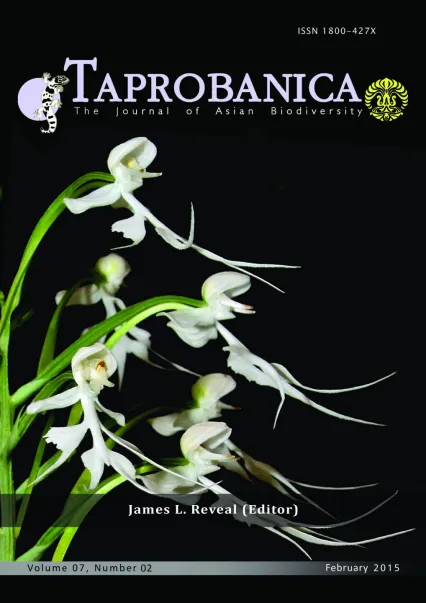

v7i2.179
Special Issue (Plants ) | Volume 7 | Number 2 | 2015
Short Note
ISSN: 1800-427X (print)
eISSN: 1800-427X (online)
DOI:10.47605/tapro.v7i2.179
Submitted date: 16 October 2014
Accepted date: 8 January 2015
Published date: 20 February 2015
Pp. 111–113, Pl. 12.
A new location for Hubbardia heptaneuron (Poaceae)
R. Kr. Singh* & A. Garg
*Corresponding author. E-mail: rksbsiadsingh@yahoo.co.in
Presumed to have become extinct, the pendulous annual grass, Hubbardia heptaneuron Bor, became the subject of immense botanical interest due to its unusual habitat preference. Hubbardia Bor with a single species, H. heptaneuron, was described by N.L. Bor (1951) on the basis of two specimens sent to him through Rev. H. Santapau (1903–1970). These specimens were actually collected in 1919 by L.J. Sedgwick (1883–1925) from Jog Falls, then known as Gersoppa Falls. Initially placed under tribe Isachneae Benth. by Bor, the extremely habitat and morphological characters of the new genus entirely differentiated this remarkable species from all other grasses of the world. This led to the establishment of a monogeneric tribe, Hubbardieae C.E. Hubb. Hubbardia heptaneuron was thought to have been rediscovered in 2002 on the basis of a 2000 S.R. Yadav collections from Tillari Ghat, Kolhapur District in Maharashtra.
Section Editor: James L. Reveal
eISSN: 1800-427X (online)
DOI:10.47605/tapro.v7i2.179
Submitted date: 16 October 2014
Accepted date: 8 January 2015
Published date: 20 February 2015
Pp. 111–113, Pl. 12.
A new location for Hubbardia heptaneuron (Poaceae)
R. Kr. Singh* & A. Garg
*Corresponding author. E-mail: rksbsiadsingh@yahoo.co.in
Presumed to have become extinct, the pendulous annual grass, Hubbardia heptaneuron Bor, became the subject of immense botanical interest due to its unusual habitat preference. Hubbardia Bor with a single species, H. heptaneuron, was described by N.L. Bor (1951) on the basis of two specimens sent to him through Rev. H. Santapau (1903–1970). These specimens were actually collected in 1919 by L.J. Sedgwick (1883–1925) from Jog Falls, then known as Gersoppa Falls. Initially placed under tribe Isachneae Benth. by Bor, the extremely habitat and morphological characters of the new genus entirely differentiated this remarkable species from all other grasses of the world. This led to the establishment of a monogeneric tribe, Hubbardieae C.E. Hubb. Hubbardia heptaneuron was thought to have been rediscovered in 2002 on the basis of a 2000 S.R. Yadav collections from Tillari Ghat, Kolhapur District in Maharashtra.
Section Editor: James L. Reveal
- List of Articles & Contents





